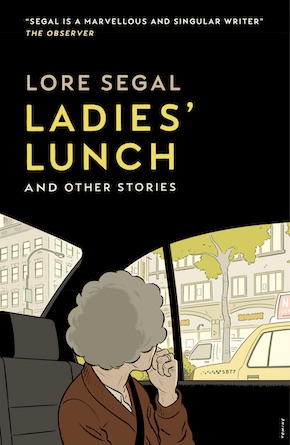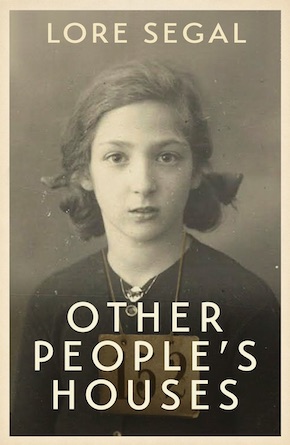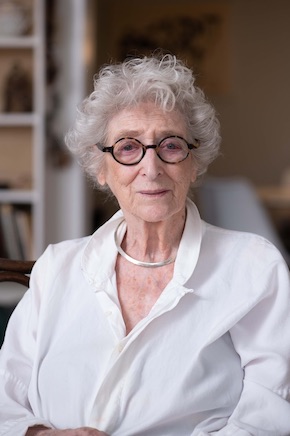Lore Segal: A life in stories
by Mark Reynolds
Lore Segal published her first Ladies’ Lunch story, ‘The Arbus Factor’ in The New Yorker in 2007, and the most recent, ‘Soft Sculpture’, in summer 2022. For her extraordinary new collection, published to coincide with her 95th birthday on 8 March 2023, she brings three new stories together into a sequence with earlier stories published in The New Yorker and elsewhere. The scene-setting title story, from 2017, sees one of the close friends, now all in their nineties, placed in a care home against her will, and the other ladies conspire to visit her and bring her back to her beloved riverside apartment. In addition to that sequence, there are three independent stories and three previously unpublished pieces of memoir. I fired off some questions to Lore to discuss the new collection and touch upon her fictionalised memoir Other People’s Houses, first published in book form in 1964 and reissued in 2018 by Sort of Books with a new afterword, which evokes her experience as a Kindertransport refugee in England from Vienna during WWII.
Mark: First off, happy birthday! Ladies’ Lunch came out on your 95th. How else have you been celebrating?
Lore: My daughter came to spend the day and we played Scrabble. Two friends came for lunch and the whole family will be coming at the weekend and we’ll watch a movie. All day long the phone rang or the doorman called to say someone had sent flowers and a great package arrived from Zabar’s from a friend in Chicago.
Can you say a little about the inspiration behind the earliest story in the Ladies’ Lunch sequence, ‘The Arbus Factor’.
Oh yes, ‘The Arbus Factor’ came from when I was in hospital one day going up the elevator, and all the people in it were old and looked to me like gargoyles and they looked at me as if I was a gargoyle… it is the surprise of seeing yourself not as yourself but as you look to others. No one thinks they look like that but that is how we actually look. My character Hope says (though many people fail to notice this) that this would be an interesting thing to talk about when they next have lunch. She has found an agenda. And that is where stories start; when you think “Ah this is something that is interesting, I could write a story about this.”
Loyal readers will know the characters in the main story sequence from your earlier fiction. What particularly appeals about recording these ladies meandering into old age?
It’s recording what’s happening. The meandering is what we’re in the process of doing, and observing ourselves doing it and talking about it is what we do.
Biographical elements glimmer through your fiction, and your autobiographical writing is fictionalised, as you say, “because I experience and remember and understand like a storyteller rather than a historian or a journalist.” But how much in the Ladies’ Lunch stories is based on your own experiences, your real friends, your actual apartment…
Five-and-half per cent plus.
In ‘Pneumonia Chronicles’ you describe your two weeks in hospital during the pandemic. It’s a funny and ultimately uplifting read, but what were your most troubling thoughts during that time?
I don’t know about ‘troubling’ but certainly one thought was “this is something to write about.” It was Covid time so my children could not visit. My son Jacob brought coffee but had to leave it down in reception.
The head can decide this is time for reconciliation but the nerves and the blood remember.”

‘Making Good’ is a provocative and comical portrayal of the awkwardness of bridge-building and reconciliation for Holocaust survivors and their families. I was recently reading about an Israeli TV comedy called Berlin Blues, in which a Jewish couple relocates from Israel to Germany, which would have been unthinkable (and still is) for older generations but has become a popular (if not unproblematic) choice for young Israelis. Is it time for every generation to move on and accept that there’s good and bad wherever they choose to be?
When I visit Vienna, which I have done to read and lecture there, I find that at first I’m intensely excited, rushing out of the hotel to run up and down to see everything. But the following day I want to go home to New York. The head can decide this is time for reconciliation but the nerves and the blood remember.
As you recount in Other People’s Houses, at ten years old you wrote to the authorities to secure visas for your parents to join you in England. Most Kindertransport children never saw their parents again. How confident were you that your letters would reach the right recipient and have the desired outcome?
Thinking now about my assumptions that I was the cause of my parents being brought out – I am no longer so sure. I have come to wonder… When you put a letter in a mailbox you have no idea what becomes of it. I do not know how my parents got out. I simply do not know what happened. In fact I asked a friend in Vienna if that could be researched – what was the process of their collecting the papers and permissions to leave Vienna, to enter England?
Most of the children went to work to get their folks out. Almost everybody that I ever talked to had written letters or applied to people in England.
How would you sum up your feelings about England then and now?
I don’t sum up my feelings. I love England unreasonably. A friend of mine once said, “Since you guys can’t be one hundred per cent English you want to be one hundred and fifty per cent English.” But I’ve given up thinking I want to go back there. The way I handle it is by watching The Great British Baking Show and The Repair Shop. I love watching English/British people shake hands.
You made an emotional first return to Vienna in 1968. How often have you been back since, and under what circumstances?
On many of my earlier trips I would go to the Literaturhaus in Vienna. It has an Exile Wing dedicated to the writing of what they call exiles – we don’t think of ourselves as exiles; we were refugees, which is a different kettle of fish. I’ve been back many times, on two recent occasions to receive a prize and to be honoured … for having been thrown out and becoming a writer.
Do you still make a point of sitting down to write every day?
No. I don’t make a point. It’s become a habit which is easier to continue than to break.
What will you be writing next?
More Ladies’ Lunch stories.
—

Lore Segal was first published in The New Yorker in 1958 and remains a regular contributor in her nineties. She has won an American Academy Award (for Her First American), the O. Henry Award and was nominated for a Pulitzer (for Shakespeare’s Kitchen). Ladies’ Lunch and Other People’s Houses are published by Sort of Books.
Ladies’ Lunch
Other People’s Houses
@SortofBooks
Author photo © Ellen Dubin Photography
Cover illustration © Adrian Tomine/The New Yorker
Mark Reynolds is a freelance editor and writer, and a founding editor of Bookanista.
@bookanista
wearebookanista
bookanista.com/author/mark

